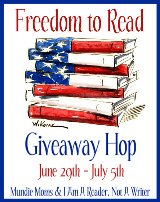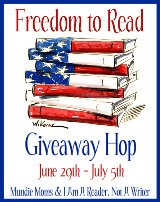 Welcome to my blog! The week of 29 June – 5 July, I’m participating with more than two hundred other bloggers in the “Freedom to Read” giveaway hop, accessed by clicking on the logo at the left. All blogs listed in this hop offer book-related giveaways, and we’re all linked, so you can easily hop from one giveaway to another. But here on my blog, I’m posting a week of Relevant History essays, each one focused on some facet of the American War of Independence. To find out how to qualify for the giveaways on my blog, read through each day’s Relevant History post below and follow the directions. Then click on the Freedom Hop logo so you can move along to another blog. Enjoy!
Welcome to my blog! The week of 29 June – 5 July, I’m participating with more than two hundred other bloggers in the “Freedom to Read” giveaway hop, accessed by clicking on the logo at the left. All blogs listed in this hop offer book-related giveaways, and we’re all linked, so you can easily hop from one giveaway to another. But here on my blog, I’m posting a week of Relevant History essays, each one focused on some facet of the American War of Independence. To find out how to qualify for the giveaways on my blog, read through each day’s Relevant History post below and follow the directions. Then click on the Freedom Hop logo so you can move along to another blog. Enjoy!
 Relevant History welcomes historical military artist Don Troiani, a soul lost in time, a 21st-century artist to whom the life of the common soldier of the American Revolution through the Civil War is as familiar and vivid as the surroundings of his Connecticut studio. No other painters have turned their attention to historical art with Don’s enthusiasm, insight, and historical accuracy. He sets standards of excellence and authenticity in his field that few can equal: in his choice of models as well as his research of garb, gear, and period settings. For more information, check his web site, online gallery, and Facebook page.
Relevant History welcomes historical military artist Don Troiani, a soul lost in time, a 21st-century artist to whom the life of the common soldier of the American Revolution through the Civil War is as familiar and vivid as the surroundings of his Connecticut studio. No other painters have turned their attention to historical art with Don’s enthusiasm, insight, and historical accuracy. He sets standards of excellence and authenticity in his field that few can equal: in his choice of models as well as his research of garb, gear, and period settings. For more information, check his web site, online gallery, and Facebook page.
*****
SA: For a long time, the Northern theater of the American War of Independence received the greatest share of attention from artists as well as scholars. You’ve painted exciting scenes from four critical battles in the Southern theater: Kings Mountain, Cowpens, Guilford Courthouse, and Eutaw Springs. What inspired you to explore these Southern battles as subjects for your paintings?
DT: My plan is to paint all of the major battles of the Revolution, and of course the fighting in the South is an important part of that , as the war was eventually decided there. Most previous (and some more current) renderings of these battles are inaccurate, and I hope to remedy that situation.
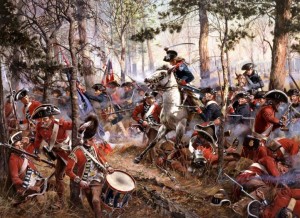 SA: To that end, you should benefit from the outcome of archeological projects ongoing at sites of battlegrounds in the Southern theater. In your painting of the Battle of Cowpens, you capture the ambiance of a backcountry South Carolina dawn in January. What research do you perform to depict the atmosphere of Southern battles so well?
SA: To that end, you should benefit from the outcome of archeological projects ongoing at sites of battlegrounds in the Southern theater. In your painting of the Battle of Cowpens, you capture the ambiance of a backcountry South Carolina dawn in January. What research do you perform to depict the atmosphere of Southern battles so well?
DT: I used photos taken by a friend on the Cowpens battlefield close to the date and time of the actual battle so the lighting would be correct. I always try to visit the actual location and, failing that, have someone else do it for me.
SA: How long did it take you to finish this painting of the Battle of Cowpens?
DT: Not counting research, a painting like Cowpens might take two months easel time, more or less.
SA: How many in-progress paintings do you have in your studio right now?
DT: Usually I work on one at a time, straight though. Because of the detailed historical nature of the work, it’s the only way to keep the facts fresh in my mind. If I were to stop for a month and go back to an unfinished painting, I’d have to reread all the research materials again. Occasionally, I will stop to do one of the single figure studies. There is one in-progress painting in the studio now. The next one is being posed, and the next three in are in various stages of research. There is another that’s completely researched and partly posed, but it is on a back burner, as time sensitive, commissioned work must come first.
SA: Many book authors work in a similar manner.
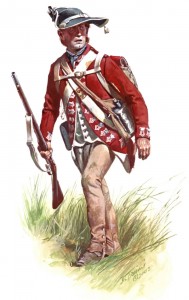 SA: The 33rd Regiment of Foot enjoyed a long and distinguished history that dated from about 1702. In the Southern theater of the Revolutionary War, this infantryman you’ve painted from the 33rd may have fought at the sieges of Charleston and Yorktown as well as the battles at Camden and Guilford Courthouse. How did you develop the deep level of detail for his uniform and equipment?
SA: The 33rd Regiment of Foot enjoyed a long and distinguished history that dated from about 1702. In the Southern theater of the Revolutionary War, this infantryman you’ve painted from the 33rd may have fought at the sieges of Charleston and Yorktown as well as the battles at Camden and Guilford Courthouse. How did you develop the deep level of detail for his uniform and equipment?
DT: I have been studying British uniforms for decades and collecting original items to incorporate into my painting. I consult with other experts and read original documents, returns, and inspection reports to complete an accurate picture of how these soldiers looked.
SA: Why do you occasionally use historical reenactors as models for your paintings?
DT: I rarely use reenactors dressed in their own uniforms, as most uniforms are not accurate enough for what I need to achieve, although a few are. I prefer models dressed in my uniforms and equipment here at the studio because it is easier to manage the authenticity. Reenactors do pose very well, however, as they understand the drill and firearms. I also do not take pictures of reenactors at events. Although some artists create paintings from pictures taken at reenactments, that’s exactly what you get: a painting of a reenactment. Living history is important and a lot of fun but has limited value to serious historical artwork.
SA: In my experience, the greatest contribution of living history is its hands-on element—and thus its capacity to inspire participants and spectators into learning more about history on their own after most have endured a bone-dry history class in high school.
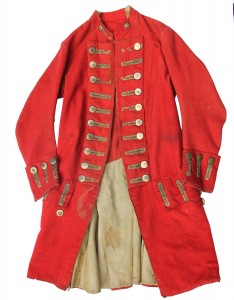 SA: You have an extensive private collection of artifacts, such as this regimental coat worn by Lt. Colonel Benjamin Holden of Doolittle’s Minute Regiment 1774–1776. (Holden led his regiment at Bunker Hill and undoubtedly was wearing his coat during the fighting.) You use these pieces to help you develop depth in your paintings. On your web site, you state, “You can look at a picture of an artifact for days and still not know it. But examining it in your own hands reveals its texture, its substance and how it works.” What’s the most memorable insight you’ve derived from examining an artifact in your own hands?
SA: You have an extensive private collection of artifacts, such as this regimental coat worn by Lt. Colonel Benjamin Holden of Doolittle’s Minute Regiment 1774–1776. (Holden led his regiment at Bunker Hill and undoubtedly was wearing his coat during the fighting.) You use these pieces to help you develop depth in your paintings. On your web site, you state, “You can look at a picture of an artifact for days and still not know it. But examining it in your own hands reveals its texture, its substance and how it works.” What’s the most memorable insight you’ve derived from examining an artifact in your own hands?
DT: If you know something inside and out, it’s a huge advantage. There is no substitute for an intimate knowledge of the weaponry and uniforms of the era. It’s important, say, to know that a sleeve reaches to the wrist and how tight it would be to get a true period look.
*****
A big thanks to Don Troiani!
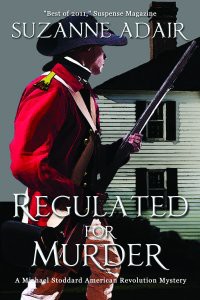 Contribute a legitimate comment on this post by Sunday 1 July at 6 p.m. ET to be entered in the drawing to win one of two autographed copies of my book, Regulated for Murder: A Michael Stoddard American Revolution Mystery. Delivery is available worldwide. Make sure you include your email address. I’ll publish the names of all drawing winners on my blog the week of 9 July.
Contribute a legitimate comment on this post by Sunday 1 July at 6 p.m. ET to be entered in the drawing to win one of two autographed copies of my book, Regulated for Murder: A Michael Stoddard American Revolution Mystery. Delivery is available worldwide. Make sure you include your email address. I’ll publish the names of all drawing winners on my blog the week of 9 July.
**********
Did you like what you read? Learn about downloads, discounts, and special offers from Relevant History authors and Suzanne Adair. Subscribe to Suzanne’s free newsletter.







